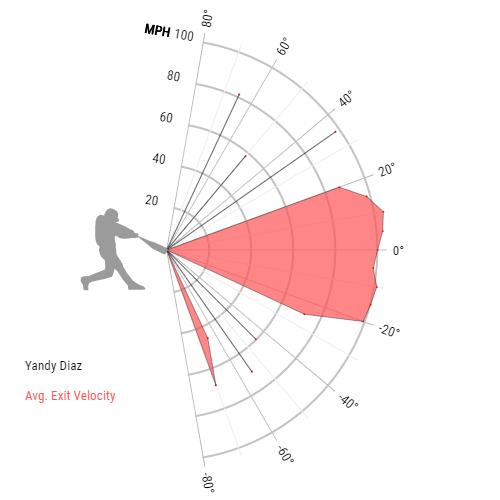Every batted ball in a baseball game is hit at a certain angle, and Major League Baseball has been tracking all of those angles for all games since the 2015 season. This is one of the easier advanced statistics to understand. Here is a helpful diagram that helps visualize these possible launch angles:

Practice fast mock drafts with our fantasy baseball software ![]()
You can see that a ball hit at a negative angle is going to hit the ground pretty quickly, and a ball hit at an angle above 50 is going more or less straight up into the air. These extreme launch angles will result in outs most of the time. The “sweet spot” for launch angle is between 10 and 50 degrees. This is where almost all extra-base hits come from.
This is also what ground balls, fly balls, and line drives are derived from. Here are the angle breakdowns for each:
- Ground ball: Less than 10 degrees
- Line drive: 10-25 degrees
- Fly ball: 25-50 degrees
- Pop up: Greater than 50 degrees
Line drives result in singles, doubles, and triples at a higher rate than the other classifications, and almost all home runs are classified as fly balls.
You can use launch angle as a predictive tool to analyze which players should be expected to hit more or less extra-base hits moving forward. If a hitter is frequently registering two-degree launch angles, they are not likely to hit many home runs in the future unless something changes. On the flip side, if a hitter is seeing most of his batted balls come off the bat at a 45-degree launch angle, that suggests his swing is likely to deliver more extra-base hits in the future.
One thing to be careful about is just looking at an “average launch angle” for a player early in the season. For example, if a player has two batted balls, one at 80 degrees (a pop up) and one at -10 degrees (a ground ball), the average of those two angles will be 35 degrees (a line drive). The average launch angle would suggest the hitter is usually hitting line drives, despite the fact that he has not hit any line drives.
The best way to combat this is to use Baseball Savant’s launch angle visuals. Here is an example:

This shows the frequencies of each angle for the player instead of just the average. From this visual you can really see that the large bulk of of the hitter’s batted balls have been between -20 and 20 degrees, suggesting that he profiles to be a higher batting average player without a ton of home runs.
It is also important to factor in exit velocity when looking at launch angles since you would expect much different outcomes for a ball hit at a 40-degree angle depending on the velocity. A ball hit at 40 degrees with a 105 mile-per-hour launch velocity will probably be a home run, while one hit at 90 miles per hour could very well be a flyout.
Practice fast mock drafts with our fantasy baseball software ![]()
Jon Anderson is a featured writer at FantasyPros. For more from Jon, check out his archive and follow him@JonPgh.


